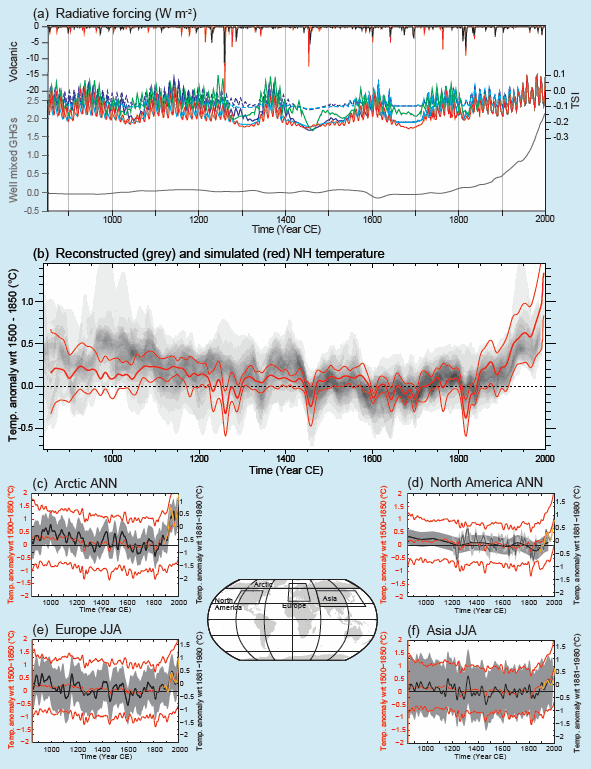


Box TS.5, Figure 1 - Simulations and reconstructions of the climate of the last millennium. Box TS.5, Figure 1 - Last-millennium simulations and reconstructions. (a) 850–2000 PMIP3/CMIP5 radiative forcing due to volcanic, solar and well-mixed green- house gases. Different colours illustrate the two existing data sets for volcanic forcing and four estimates of solar forcing. For solar forcing, solid (dashed) lines stand for reconstruction variants in which background changes in irradiance are (not) considered; (b) 850–2000 PMIP3/CMIP5 simulated (red) and reconstructed (shading) Northern Hemisphere (NH) temperature changes. The thick red line depicts the multi-model mean while the thin red lines show the multi-model 90% range. The overlap of reconstructed temperatures is shown by grey shading; all data are expressed as anomalies from their 1500–1850 mean and smoothed with a 30-year filter. Note that some reconstructions represent a smaller spatial domain than the full NH or a specific season, while annual temperatures for the full NH mean are shown for the simulations. (c), (d), (e) and (f) Arctic and North America annual mean temperature, and Europe and Asia June, July and August (JJA) temperature, from 950 to 2000 from reconstructions (black line), and PMIP3/CMIP5 simulations (thick red, multi-model mean; thin red, 90% multi-model range). All red curves are expressed as anomalies from their 1500–1850 mean and smoothed with a 30-year filter. The shaded envelope depicts the uncertainties from each reconstruction (Arctic: 90% confidence bands, North American: ±2 standard deviation. Asia: ±2 root mean square error. Europe: 95% confidence bands). For comparison with instrumental record, the Climatic Research Unit land station Temperature (CRUTEM4) data set is shown (yellow line). These instrumental data are not necessarily those used in calibration of the reconstructions, and thus may show greater or lesser correspondence with the reconstructions than the instrumental data actually used for calibration; cutoff timing may also lead to end effects for smoothed data shown. All lines are smoothed by applying a 30-year moving average. Map shows the individual regions for each reconstruction. {5.3.5; Table 5.A.1; Figures 5.1, 5.8, 5.12} Source: IPCC Related publication:
Other Figures & Tables on this publication: Box TS.1 - Treatment of Uncertainty Figure TS.1 - Multiple complementary indicators of a changing global climate Figure TS.2 - Change in surface temperature over 1901–2012 Figure TS.3 - Ice loss in Greenland and Antarctica TFE.1, Figure 1 - Changes in sea surface salinity TFE.1, Figure 2 - Changes in precipitation over 20th century TFE.1, Figure 3 - Projected changes in precipitation, 21st century TFE.2, Figure 1 - Comparison of observed trends with previous projections. TFE.2, Figure 2 - Compilation of paleo sea level data Figure TS.4 - Annual anthropogenic CO2 emissions Figure TS.5 - Atmospheric composition. Figure TS.9 - Global temperatures with and without anthropogenic forcing Box TS.3, Figure 1 - Trends in temperature changes for the last few decades. Figure TS.10 - Likely ranges of warming trends. TFE.4, Figure 1 - The Earth’s energy budget from 1970 through 2011 TFE.5, Figure 1 - Atlantic Meridional Overturning Circulation Figure TS.11 - Simulated and observed 1951–2011 trends in the Southern Annular Mode index by season Box TS.5, Figure 1 - Simulations and reconstructions of the climate of the last millennium. Box TS.6, Figure 1 - Modeled patterns of temperature and precipitation changes. TFE.6, Figure 1 - Climate sensitivity TFE.6, Figure 2 - Climate response Figure TS.13 - Decadal prediction forecast quality of several climate indices. Figure TS.14 - Synthesis of near-term projections of global mean surface air temperature Figure TS.15 - Annual mean temperature change Figure TS.18 - Northern hemisphere snow cover and permafrost area over the 21st century TFE.7, Figure 1 - Percentage of CO2 pulse remaining in the atmosphere after a number of years Figure TS.21 - Projections of global mean sea level Figure TS.22 - Projections from process-based models of global mean sea level Figure TS.23 - Sea level rise in different scenarios TFE.8, Figure 1 - Temperature increases in different scenarios Figure TS.26 - Projected changes in tropical cyclone statistics. TFE.9, Figure 1 - Global projections of the occurrence of extreme events Table TS.2 - Overview of projected regional changes and their relation to major climate phenomena. |